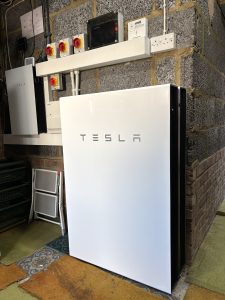Tesla Powerwall – More of a ‘Luxury’ Than an ROI Winner!
We had our first Powerwall 2 installed in November 2022, which provides a storage capacity of 13.5 kWh. The Tesla Gateway, installed alongside, acts as the ‘brains’ of the system, communicating via iOS or Android devices using the Tesla app. The Powerwall is located in our unheated utility area, sheltered from extreme weather conditions. With an average winter ambient temperature of around 12°C, I hope this environment will help extend the battery’s lifespan (I’m only 77 and want to enjoy many more years of use!).
Our 8.1 kWp solar array, consisting of 21 panels, is connected to the Gateway. Each panel has its own Enphase IQ7A micro-inverter. We also have the Enphase Envoy unit, as the solar PV system was installed several months before the Tesla equipment, and we would have had no way to monitor the PV system otherwise.
The Powerwall units feature a sleek white glass front and can be wall- or floor-mounted. They can also be ‘stacked’ one in front of the other, creating a neat installation for the two units that now provide a combined 27 kWh of storage. The Gateway is wall-mounted to the left of the heavy battery and connects to our solar PV system, the grid (after the smart meter), and our consumer unit. We’ve also installed a separate earth rod for grounding when isolated from the grid.
Other articles cover electrical safety and the need for complete isolation from the grid during power outages. Battery owners can continue using stored power or energy from solar PV panels via the Gateway, even charging the Powerwall with solar energy during such times. I won’t delve further into this topic here.
At the time of installation, Powerwalls were as rare as hen’s teeth, and we waited about nine months for delivery of the first unit. We had expressed interest in adding a second unit when installing a heat pump, but our supplier advised waiting to see how the first unit performed. Later, we were told that paying a 25% deposit could secure delivery by February 2024 (15 months later!), but we declined due to the even higher price quoted compared to what we’d paid for the first unit.
When our heat pump was installed in February 2023, the company offered a Powerwall 2 at a significantly lower price, with delivery in just a few weeks. We placed the order, and the second unit was installed in front of the original one – space we had already planned for. This addition increased our storage capacity to 27 kWh, creating a very tidy setup with all control equipment for solar, storage, Wi-Fi, and network links neatly arranged on the same wall.
The Tesla app offers a wide range of options for managing energy use. We can charge the battery at the lowest rates on our tariff, draw energy from the battery or solar PV as needed, and even export energy from the PV and battery to suit our preferences. We also use the NetZero app to complement the Tesla app, allowing us to make subtle adjustments daily. Currently, we’re on Octopus Energy’s Cosy tariff, which provides three low-rate periods throughout the day. This enables us to charge the battery, power our all-electric home, and avoid higher rates entirely.
ROI? Well… if your primary goal is a return on investment, the Tesla Powerwall system might not be for you! We save significantly by using only the cheapest rates on our tariff, and with energy prices so volatile (read: constantly increasing), it’s hard to predict future savings. However, the ability to choose when to use grid power to charge the battery allows us to maximise our tariff benefits while using the greenest energy available.
In short, ROI isn’t the standout feature of a battery installation. While a Tesla Powerwall isn’t a cheap option (and DIY installations using components from various sources can offer significant savings), the system is sleek, reliable and provides a certain ‘smugness’ during storm warnings!
The latest model, the Powerwall 3, offers a few additional features, including a higher current draw from the battery and an integrated Gateway, which should reduce installation time and cost.
Toodles, heats his home with cold draughts and cooks food with magnets.
I had solar panels (nominal 4kW) installed in 2017 and quickly realised that there was a mis-match between generation and domestic demand so a Powerwall was installed in 2018. This meant that much of the domestic use in summer months came from the solar generation. The facility for mains charging came several years later. Initially, Tesla's "intelligent" algorithm was often stupid because it was based on history and would assume that a sunny day would be followed by another sunny day, etc. This was later improved by considering the regional solar generation forecast (OK for very sunny or very cloudy days but less good for mixed sun and cloud).
I had a second Powerwall installed nearly two years ago in anticipation of a heat pump. This additional battery capacity also meant that that there was sufficient ability to carry over power from sunny days to dull ones during the summer months with no usage of mains power. I also had the backup Gateway fitted (this wasn't available when the first battery was installed). The off-line capability came very useful a few months ago when the local supply cable blew up causing a 9 hour outage. There have been about 10 days during the past winter when the electricity consumption exceeded the total battery capacity before the next recharge period arrived (Octopus Go tariff with cheap power 00:30 to 05:30).
My Powerwalls are in the garage which gets down well below 10C in cold winter weather. The batteries have their own thermal management to keep within a comfortable temperature range. The garage, however, never gets hot as it's on the north side of the house. I suspect that the thermal management is one reason why the long term efficiency (power out vs power in) is about 85%. Powerwalls are very neatly packaged.
Any ROI calculation needs to factor in all the unknowns such as the future electricity cost and the potential earnings foregone had the money been invested elsewhere. The convenience of tolerance to electricity suppy interuptions also can't be ignored.
We had our Tesla Powerwall 3 (and Gateway) installed earlier this month, together with a doubling of our installed solar capacity, going from 3.6kWp to 7.2kWp.
Taken alone, I'm not sure we will ever see a financial return on the cost of the battery, but there was more to our decision than ROI alone.
We have signed up for Intelligent Octopus Flux (IOF) tariff which is certainly helping with the financials during summer. We use around 10-12kWh/day in summer and can generate 4 times that on a good day, so a net metering tariff such as IOF that pays 22.3p day rate and 29.8p at peak rate for our net export works out far better than a cheap import tariff paying 15p SEG.
Before I switched to IOF, we were on Cosy ToU for a couple weeks (and will use Cosy for the 6 winter months where we are net importers) and the PW3 worked well, running the house from battery during more expensive periods and charging from excess solar during the day and drawing from the grid in the cheap slots.
Our battery is installed outside on an east facing wall due to lack of other suitable options. One of the reasons we chose a Tesla is their market leading thermal management which is particularly important when installing outside. If we had any suitable indoor locations, I may have considered other brands, but we didn't. We will have to see how well it performs in Winter.
Posted by: @johnrMy Powerwalls are in the garage which gets down well below 10C in cold winter weather. The batteries have their own thermal management to keep within a comfortable temperature range. The garage, however, never gets hot as it's on the north side of the house. I suspect that the thermal management is one reason why the long term efficiency (power out vs power in) is about 85%. Powerwalls are very neatly packaged.
Interesting what you say about efficiency - I will look at my figures once I have a month's worth of data, correcting for the 36% charge it arrived with. To date I'm seeing ~97% efficiency but I suspect it's a lot more efficient in summer than winter due to operating in it's optimum range, and that it's charged 76% from DC-coupled solar and only 24% from AC grid, so inverter losses are lower than they may be in winter. The PW3 manual quotes 97.5% for Solar to home/grid, and 89% for round trip efficiency.
Samsung 12kW gen6 ASHP with 50L volumiser and all new large radiators. 7.2kWp solar (south facing), Tesla PW3 (13.5kW)
Solar generation completely offsets ASHP usage annually. We no longer burn ~1600L of kerosene annually.
Posted by: @toodles
When our heat pump was installed in February 2023, the company offered a Powerwall 2 at a significantly lower price, with delivery in just a few weeks. We placed the order, and the second unit was installed in front of the original one – space we had already planned for. This addition increased our storage capacity to 27 kWh, creating a very tidy setup with all control equipment for solar, storage, Wi-Fi, and network links neatly arranged on the same wall.
I know this is pretty old, but wanted to double check something as it is very important for battery upgrades. Did you had the Heat Pump installed by the same exact company that installed the original PW2? Because from what I understand, any expansions MUST be installed by the original installer, or else you void your warranty. Unless the original installer has gone bust, and Tesla can recommend someone else to perform the upgrade, and cover the new and old system.
This seems to be based on the brand, for example Tesla, tightly controlled, very likely your warranty is voided by using any other installer than the original, unless another Tesla certified and approved installer, but worth checking with them first. Other brands, more forgiving but still worth checking with them first.
@drei The second PW2 was installed by the same company who installed our heat pump; the company who installed the first PW were really not interested, they quoted 12-15 months delivery and approx. £2000 above the price of the first one. The company who supplied and fitted the second are accredited installers for Tesla Powerwalls. Regards, Toodles.
Toodles, heats his home with cold draughts and cooks food with magnets.
Also, though they weren’t prepared to match the price they had indicated for the second Powerwall at the time the first one was installed, they still required a 25% deposit on that order for 12-15 months hence! Toodles.
Toodles, heats his home with cold draughts and cooks food with magnets.
- 26 Forums
- 2,367 Topics
- 53.7 K Posts
- 449 Online
- 6,042 Members
Join Us!
Worth Watching
Latest Posts
-
Connecting Growatt SPH5000 over wired ethernet rather than wireless
Hi all I've recently had a Growatt sph5000 inverter i...
By z8lccda , 7 minutes ago
-
RE: Help needed with Grant Aerona 3 issues
First time posting so bear with me. Some bits that have...
By Adamp , 3 hours ago
-
RE: Mitsu PUHZ-SW120YHA + EHSC-VM20Uk - Performance
All understood. Obviously its a bit house de...
By JamesPa , 4 hours ago
-
RE: Water Hammer After Heat Pump Install
From OPs description I had the impression (quite possib...
By JamesPa , 6 hours ago
-
RE: Who's your electricity provider and what's your tariff?
@majordennisbloodnok This may be a better thread to ...
By Batpred , 24 hours ago
-

RE: Best Heat Pump Brand in the UK
Last Call to Vote & Win! Haven't voted for your Hea...
By Mars , 1 day ago
-

RE: Solis S6-EH1P8K-L-PLUS – Why I Chose It and What I’ve Learned So Far
Interesting question. To be frank, since I have no inte...
By Majordennisbloodnok , 2 days ago
-
RE: Changing from 4-port buffer to volumizer
@andy1618 see the very sage advice from @editor above. ...
By JamesPa , 2 days ago
-
RE: New Fogstar 15.5kWh upright solution
The video shows the JK balancer, but the connection of ...
By Batpred , 2 days ago
-
RE: Ecodan unable to hit legionella target temp - what's the consensus?
@9jwr9 Hi, yes this is the issue with every (stand alon...
By ASHP-BOBBA , 2 days ago
-
RE: Help me keep the faith with my air source heat pump installation
@adamk FWIW I managed unintentionally to 'coax' mine in...
By JamesPa , 2 days ago
-
RE: Octopus Cosy Heat Pump Owners & Discussion Thread
You are in essence right. Adia only works with selecte...
By JamesPa , 2 days ago
-

No, you haven’t missed out, @batpred. This thread’ll st...
By Majordennisbloodnok , 2 days ago
-

RE: Tesla Powerwall – More of a ‘Luxury’ Than an ROI Winner!
Also, though they weren’t prepared to match the price t...
By Toodles , 2 days ago
-
RE: How long will your energy contract last?
My INTELLI-FIX-12M-25-08-29 has less than 12 months to ...
By Batpred , 2 days ago
-

RE: GivEnergy 2025 forthcoming batteries and inverters
Then, perhaps @toodles , you should've made a submissio...
By Transparent , 2 days ago
-
RE: Balancing financial efficiency and comfort using the Octopus Cosy tariff
I am wondering if anyone with an EV could find the 7p/k...
By Batpred , 2 days ago
-
Possibly, but it would also reduce DeltaT across the em...
By JamesPa , 2 days ago
-

RE: ASHP sizing - value of Heat Transfer Coefficient
@cathoderay It was reminiscent of the BBC Open Universi...
By Toodles , 2 days ago





